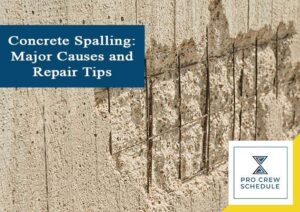It is not uncommon for builders and concrete contractors to receive calls from clients asking why their concrete is pitted and flaking. Spalling concrete is one of the most common problems where a portion of the surface breaks, peels, and chips away. This issue is also known as scaling and is often a result of a weak surface vulnerable to damage.
Today, complaints of spalling or scaling of concrete surfaces have been on the rise. To combat these issues and prevent customer complaints and callbacks, contractors must review their practices from time to time. In this article, we’re outlining some of the major causes of concrete spalling and effective ways to prevent it further.
What Causes Concrete Spalling?
Firstly, spalling isn’t a good thing to see since it makes a structured look uncared for. Worst is, if the structure is situated in areas commonly accessed by the workers and by the public in general, the spalling can be hazardous. There will be trip hazards and falling debris. And if concrete spalling is left unchecked, the structural problems tend to accelerate and spread, thus becoming more unstable.
Spalling typically occurs for one of many reasons but sometimes a mix of these reasons. Salt, especially the sodium chloride that is used on frozen roads, can result in rusting or oxidation of reinforcing steel. However, spalling typically occurs more often due to the curing process or the many ways the concrete are hardened.
Here are some other causes of spalling in the concrete:
1. Damaged Wall
Another reason why spalling occurs in concrete is water. Rainwater that comes from other external sources can make its way into the passageways of concrete. On cold days, water tends to freeze inside the concrete. It is where ice or snow forms, and it expands tremendously. The expansion can cause the concrete to break. Hence, it develops cracks on the surface.
As the cycle continues, the outer surface will also continue to undergo spalling, causing weathering. This condition is called freeze-thaw weathering.
2. Cracked Wall
One of the many reasons why concrete spalling occurs is because of the natural process named carbonation. Water will immediately seep into the concrete, and it causes other elements, especially reinforcement bars embedded in the concrete, to corrode. Hence, it creates bulges and cracks in the concrete surface. Steel reinforcement bars are often used in concrete to provide durability. Also, steel that is poor in quality can cause spalling.
3. Sandblasting
It is another cause of spalling because of poor installation. It refers to an inappropriate combination of ingredients while pouting the concrete during the construction. It also often happens when the structure is being subjected to high pressure through overloading.
4. Coldwater
During firefighting operations, the water poured on the heated concrete surface causes the spalling also. The cold water being poured can break the materials like sand and gravel. It will cause the concrete to crumble.
5. High temperatures
When the temperature tends to get higher, spalling is expected. When concrete is exposed to high temperatures either suddenly or over time, the surface gets hotter compared to underneath. The condition leads to differential thermal expansion, which can result to stress between the surface areas. Additionally, large masses of concrete start to detach and develop cracks.
6. Rock salts and De-icing salts
Water that contains dissolved salts will penetrate the concrete. As a result, it will crystalize inside it during water evaporation. The salt crystals will expand in volume, resulting from creating stress on the concrete. Therefore, it wears away the surface.
Note: The signs of spalling are flaky and chipped surface, concrete starting to crack, and chunks coming out from the installation. The above-cited signs might also include discoloration, marked lines, and roughness. The ideal time to address spalling issues is when concrete is first poured. Hence, taking steps to prevent this issue from occurring is necessary.
Tips for Fixing and Preventing Spalled Concrete
Remedies and solutions for concrete spalling often vary by how severe the problem is. Moreover, the location of the concrete structure, the type and other related factors are also considered. Below are some effective tips that can help a contractor in repairing spalled concrete.
- Due to exposure, corroded rebar should be cleaned at the start of the restoration process. When the rebar is fully cleaned using a wire brush and the corrosion is finally eliminated, the rebar must have a protective coating. The coating is meant for rust inhibitors to reduce future corrosion.
- Damage found on walkways, driveways, and other horizontal surfaces should be repaired with a cementitious overlay. Right after the overlay has entirely set, a waterproofing membrane must be applied to prevent concrete spalling from occurring.
- When the spalling damage is lower than one-third of the concrete’s thickness, the concrete can possibly receive a surface repair. Yet, if the damage is much tremendous than one-third of the concrete’s depth, steel bars must be installed right away. Also, a full-depth restoration should also be required.
- Surfaces to be patched have to be free from all fine particles and debris. The surfaces have to be fully dry also before patching material is applied. It is best if the old concrete surface is hard to provide tooth for much better bonding.
- The team should use construction scheduling software to sort everything, from resources to crews involved. This software solution makes the work easier, but it also improves the productivity of the crew.
- Patching is considered as a repair option for localized damage or any random damage. Patches have to extend at least five inches beyond the spalled areas. The contractors need to be extra careful when considering this option. For best results, the surface might be saw-cut in the patch area. Doing so helps in containing and securing the patch.
- A contractor should consider using the best pathing materials. Epoxy and Portland-cement-based epoxy must be mixed quickly prior to the application. Manufacturers often give the best guidelines on what to do.
- Repair materials must have an expansion coefficient that is quite similar to the original concrete.
- Any joints that are repaired should allow for an expansion of the concrete slab.
- Ensure that the air temperature is above forty-degrees Fahrenheit if you expect the patching to work well.
- Review the finishing and placing procedures because early concrete finishing cerates issues related to scaling.
- Project leaders have to implement project management for construction because it plays an integral part in the project’s development.
- Before the joint is repaired, make sure that it is restored properly to give allowance for the expansion of the slab.
- Review the concrete mix design order. Work with the ready-mixed concrete supplier to obtain a group of mixes that cover all temperature variations and seasons.
- Check your finishing and placing tool. Make sure to check floats for uneven edges and the hand tools for wear, searching for worn grooves and sharp edges.
- Make follow-ups with the owner specifically for preventative maintenance.
Moreover, concrete repairs should be carried out correctly and should be in accordance. Only a qualified contractor can do some repairs since the selection of the repair materials is critical. These materials that are to be used for the repair have to be compatible with the host concrete.
How Project Management Software Makes Work Easier for Concrete Contractors?
Advanced software solutions designed for project management have played a fundamental role in the industry. Today, most concrete jobs require project leaders to organize, estimate project costs, plan, and schedule everything. This sophisticated software is designed for many purposes that aid better decision-making and team collaboration.
Here are the top advantages of this software solution that makes the work easier:
- Reworks are avoided – one of the things that needed to be avoided during project execution is rework because it is costly. Using this advanced software tool, reworks are most likely prevented or not going to happen at all.
- Notify team members –Notifications regarding the work can easily show. The software allows everybody to send some updates about tasks and other activities, either it’s done or in process. Incorrect deliverables are also avoided to happen.
- Time-tracking – labor hours are time-tracked and it will be easier for project leaders to monitor each member. It is very beneficial because work is done correctly and fairly.
- Resource and crew management – the construction team and resources are best managed using the software application. Everything falls into the right place and category. Tracking each member and even the resources used saves time.
- Real-time communication – between project leaders and their team, relationships with one another matter. The software helps the team to be more open and to discuss work-related matters freely. It has features that will allow every participating member to communicate and to connect with one another despite going to other places.
- Cloud-based storage – all files and documents are saved and kept securely. It is cloud-based software, and it allows everyone from the team to access it anytime and anywhere.
Key Takeaways
A contractor must pay special attention to the corners and edges of exposed concrete when dealing with spalling concrete. There are other alternatives, but doing so helps ensure adequate concrete cover, as indicated by some structural engineers. Spalls in the concrete can be effectively avoided if the concrete is carefully managed and when proper techniques are utilized during when pouring process.







